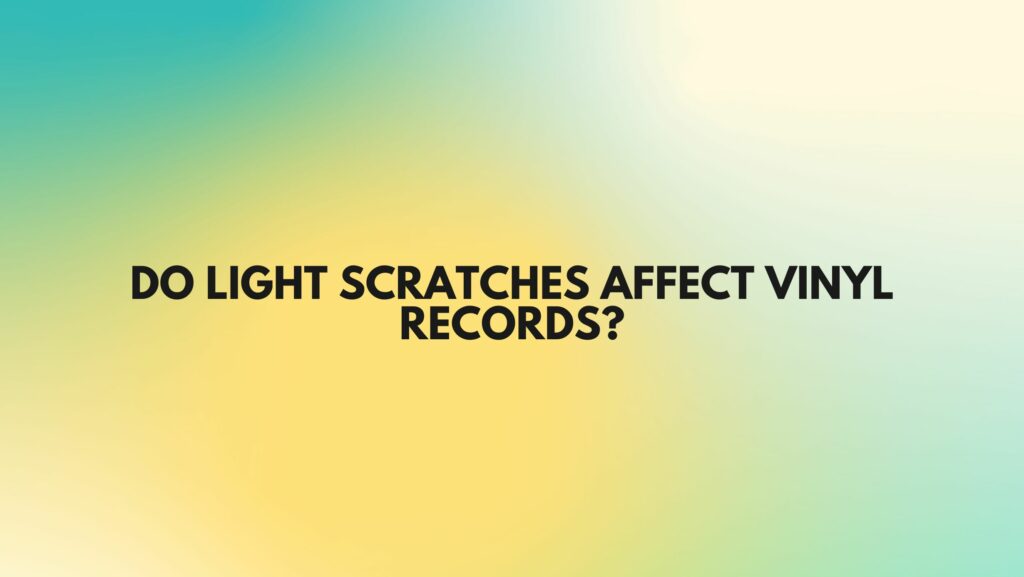Vinyl records have experienced a resurgence in popularity, celebrated for their rich, warm analog sound. However, like any physical medium, they are susceptible to wear and tear over time. One common issue collectors face is the presence of light scratches on their records. In this comprehensive article, we will explore the world of vinyl records and investigate whether light scratches can affect the listening experience, what causes them, and how to prevent and mitigate their impact.
I. The Anatomy of a Vinyl Record
Vinyl records are flat, circular discs made of polyvinyl chloride (PVC). Their grooved surfaces contain the audio information, and these grooves are followed by a stylus (needle) attached to a tonearm, which translates the physical grooves into sound.
II. The Impact of Light Scratches
- Audible Imperfections: Light scratches on vinyl records can result in audible imperfections during playback, such as occasional pops, clicks, or faint surface noise. These imperfections are a direct result of the stylus encountering disruptions in the grooves as it traces the path of the music.
- Minimal Sound Quality Impact: In most cases, the impact of light scratches on sound quality is minimal. Depending on their depth and location, these imperfections may not be very noticeable and can often be tolerated or even improved with proper cleaning and playback equipment adjustments.
- Potential for Enhanced Warmth: Some audiophiles even argue that minor surface noise and imperfections can contribute to the vinyl experience, adding a certain warmth and character to the sound that digital formats may lack.
III. What Causes Light Scratches on Vinyl Records?
Light scratches can be caused by various factors, including:
- Handling: Mishandling records, especially when inserting or removing them from their sleeves, can lead to surface scratches. Always handle records with clean hands and by their edges to minimize the risk of contact with contaminants or damaging particles.
- Dust and Debris: Dust, dirt, and debris on the record surface can act like abrasive materials when the stylus moves across them, causing scratches. Regular cleaning is essential to minimize these surface imperfections.
- Poor Needles and Cartridges: Worn or misaligned stylus needles, as well as subpar cartridges, can contribute to scratches by causing uneven pressure and tracking issues during playback. Regular maintenance of your turntable and stylus is crucial.
- Environmental Factors: Exposure to environmental conditions, such as humidity and temperature fluctuations, can affect the integrity of records and increase the risk of surface scratches. Proper storage in a controlled environment is essential.
IV. Prevention and Mitigation
Preventing and mitigating the impact of light scratches on vinyl records requires a combination of proper handling and maintenance:
- Cleaning: Regularly clean your records with a dedicated vinyl record brush, carbon fiber brush, or antistatic brush to remove dust and debris that can lead to scratches.
- Record Sleeves: Store your records in dust-free, antistatic inner sleeves, and use protective outer sleeves to safeguard them from physical damage and environmental factors.
- Correct Turntable Setup: Ensure your turntable is correctly set up with a well-aligned cartridge and a well-maintained stylus to minimize tracking errors.
- Gentle Handling: Handle your records with care, avoiding contact with the grooved surface. When placing or removing them from the turntable, do so gently and deliberately.
- Correct Turntable Settings: Ensure that your turntable is set to the correct tracking force, anti-skate, and vertical tracking angle for your cartridge to prevent excessive pressure on the grooves.
V. Conclusion
Light scratches on vinyl records are a common concern for collectors, but they don’t have to spell the end of your listening pleasure. While they can introduce minor imperfections into the listening experience, these issues are typically manageable with proper care, handling, and maintenance. Vinyl records, even with light scratches, continue to provide a uniquely warm and analog sound that many enthusiasts treasure. By understanding the causes of these imperfections and following best practices for record care, you can ensure that your vinyl collection remains a source of musical enjoyment for years to come.

